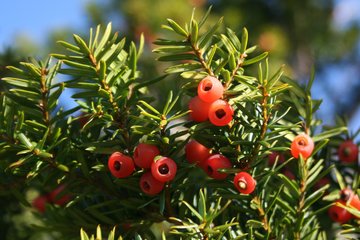Moth takes advantage of defensive compounds in Physalis fruits
The berries act as immune boosters in the moth Heliothis subflexa, a specialist on this food
Researchers from the Max Planck Institute for Chemical Ecology found that the specialist moth Heliothis subflexa benefits from secondary plant components by turning the original defensive function of these compounds into its own advantage. Withanolides, which are present in Physalis plants, usually act as immune suppressants and feeding deterrents in insects. Surprisingly, Heliothis subflexa uses these plant defenses as immune-system boosters. Moreover, withanolides protect the moth from harmful effects caused by pathogenic bacteria. The new study demonstrates a unique benefit to host-plant specialization.

In order to survive and to repel herbivores, many plants defend themselves by producing toxic or deterrent substances. In the course of evolution, many insects have succeeded in adapting to the defensive chemistry of their host plants and thereby circumventing plants’ defence mechanisms. However, the plants have also adapted their defensive system to further protect themselves against their enemies, which, in turn, generated counter-adaptations in the insects; biologists refer to this phenomenon as an “evolutionary arms race” between plants and insects. Many insects are plant pests which can be categorized as “specialists” and “generalists.” Whereas generalists feed on many different plants, specialists have adapted to one or few closely related plant species as their food. The moth species Heliothis subflexa analysed in this new study is such a host specialist.
Withanolides provide H. subflexa with direct and indirect protection
The researchers measured and compared the effects of withanolides on relative weight gains, survival rates and the immune status in two moth species: the specialist Heliothis subflexa and the generalist Heliothis virescens. They knew from earlier studies that the specialist moth possesses a weaker immune response compared to the closely related generalist. “We were surprised to find that only Heliothis subflexa benefits from withanolides by increasing larval growth and immune system activity, but not its close relative, Heliothis virescens,” says Hanna M. Heidel-Fischer, the leader of the study.
Furthermore, the research team from the Department of Entomology found that withanolides protect the specialist, but not the generalist, from the growth-suppressive effects of an infection caused by the bacterial pathogen Bacillus thuringiensis. “Larvae of Heliothis subflexa could theoretically profit in two ways from Physalis fruits: First, withanolides display antibacterial and immune stimulant activity. Furthermore, the Physalis fruit is covered by a calyx that creates a so-called enemy-free space,” concludes co-author Heiko Vogel.
Physalis: A plant with promising properties
Plants of the genus Physalis, also known as ground cherries, have a long history as a medicinal herb in India and the Middle East. The medicinal importance of Physalis plants is mainly due to the presence of steroidal lactones, the withanolides. Withanolides exhibit potential anti-cancer, anti-inflammatory and apoptotic activities. However, the actual role of withanolides in Physalis plants is defence against herbivores. Withanolides have been shown to be potent anti-feeding deterrents as well as immunosuppressants in insects. These effects can be attributed to possible interactions of withanolides with signal transduction pathways in the cells. For instance, previous studies have shown that withanolides may cause moulting disorders in insects, suggesting that the anti-feeding and immunosuppressive effects arise from the disruptive effect of withanolides on the development of non-adapted insects. These toxic effects of withanolides on herbivorous insects suggest an adaptive benefit, since few insect species are known to feed on Physalis plants with impunity.
Heliothis subflexa: A Physalis specialist
Larvae of the Heliothis subflexa moth are probably best known for their ability to feed on Physalis plants, a plant genus that includes species also attractive to humans, such as the cape gooseberry and tomatillo. In contrast to their close relative Heliothis virescens, a generalist that feeds on at least 14 different plant families but not on Physalis, Heliothis subflexa larvae feed exclusively on Physalis fruits, and it is the only Heliothis species to do so. Physalis fruits are enclosed by a thin-walled, inflated calyx called a “lantern”. The lantern provides a so-called enemy-free space for fruit-feeding larvae of Heliothis subflexa, which could be demonstrated in earlier studies. However, the impact of withanolides on specialized Heliothis subflexa had not been evaluated prior to this study. With the known immunosuppressive properties of withanolides in mind, the researchers aimed to examine the specialization of Heliothis subflexa on Physalis in the context of ecological immunology. “Ecological immunology combines classical studies of the immune system with an ecological perspective to evaluate the costs and benefits of defence against pathogens in the natural environment, and the manner in which natural selection shapes the immune system,” explains Andrea Barthel, the first author of the publication. Further studies will now focus on the mechanism by which the specialist moth circumvents plant defenses. Moreover, experiments are planned to elucidate the effect withanolides have on the bacterial communities on the plant surface as well as in the gut of the specialist insect.
AB/HHF/AO












